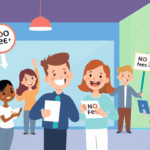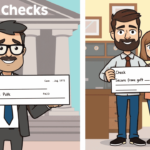Ever frantically searched your checkbook only to realize you’ve sent a payment to the wrong person? Or maybe you discovered an error in the amount after the check left your hands? Don’t panic! You’re not alone. According to banking industry statistics, Americans request over 15 million stop payment orders annually, making check cancellation one of the most common banking transactions. Whether you’ve written the wrong amount, sent a payment to the wrong recipient, or simply changed your mind about a purchase, knowing how to cancel a check properly can save you from financial headaches and potential overdrafts.
Understanding Check Processing: Why Timing Is Everything
Before we jump into cancellation methods, it helps to understand how checks are processed. In the past, physical checks would travel from bank to bank, giving you days to stop payment. Today, with electronic check conversion and image processing, your check might clear in hours, not days.
Most checks now clear through one of three systems:
- Same-day processing: Some banks offer same-day settlement
- Next-day processing: The most common timeframe
- Electronic check conversion: When a merchant converts your paper check to an electronic payment immediately
This accelerated timeline means you need to act quickly! The moment you realize you need to cancel a check, the clock is ticking.
5 Proven Methods to Cancel a Check Before It Clears
Method 1: Contact Your Bank Immediately for a Stop Payment Order
The most reliable way to cancel a check is through your bank with an official stop payment order. Here’s exactly how to do it:
- Gather your check information: You’ll need the check number, exact amount, date written, and payee name.
- Contact your bank ASAP: Most banks offer three ways to place a stop payment:
- Online banking (fastest option)
- Phone banking (check if they have 24/7 service)
- In-person at a branch (most secure but limited by business hours)
- Pay the fee: Stop payment orders typically cost between $20-$35, though some premium accounts include free stop payments.
- Confirm the timeframe: Most stop payment orders remain active for six months. Mark your calendar to renew if needed.
- Get written confirmation: Request a receipt or confirmation number for your records.
Pro tip: Many banks waive stop payment fees for premium account holders. If you make multiple stop payment requests yearly, upgrading your account might actually save you money!
Method 2: Contact the Recipient Directly
If you know and trust the recipient, reaching out directly can be the fastest (and free!) solution:
- Call, text, or email them immediately
- Explain the situation honestly
- Ask them not to deposit the check
- Request they return or destroy the check
- Send a replacement if needed
This approach works best with friends, family members, or trusted businesses. However, never rely solely on this method for high-value checks or with recipients you don’t know well.
Method 3: Monitor Your Account and Prepare for Potential Overdraft
Sometimes, despite your best efforts, you might not catch the check in time. In these cases:
- Ensure you have sufficient funds to cover the check
- Set up account alerts to notify you when large transactions process
- Keep documentation of your cancellation attempts
- Contact your bank’s fraud department if the check was stolen or you suspect fraud
Method 4: Use Your Bank’s Mobile App for Instant Action
Many banks now offer stop payment features directly through their mobile apps:
- Log into your banking app
- Look for “stop payment” under account services or check options
- Enter the required check information
- Submit your request and save the confirmation
- Check back to ensure the stop payment order was successfully processed
Using a mobile app often means you can cancel checks 24/7, even when bank branches are closed – potentially saving critical hours.
Method 5: Write a Replacement Check (When Appropriate)
If you’re canceling due to an error but still need to make the payment:
- Place the stop payment on the original check
- Write a new check with the correct information
- Include a note explaining this is a replacement for check #XXX
- Contact the recipient to inform them of the situation
This method ensures your payment obligation is still met while preventing the incorrect check from processing.
The Cost of Canceling Checks: What You Need to Know
Most banks charge between $20-$35 for a stop payment order, which typically remains active for six months. This fee applies regardless of whether the check eventually tries to clear or not.
However, there are ways to potentially reduce or avoid these fees:
- Premium checking accounts often include several free stop payments per year
- Credit unions typically charge lower stop payment fees than traditional banks
- Online banks sometimes offer discounted stop payment services
- Negotiation works more often than you might think – if you’re a long-time customer, simply ask for a fee waiver
Remember: Even a $35 fee is much less expensive than dealing with an overdraft or sending money to the wrong person!
Frequently Asked Questions About Canceling Checks
How long do I have to cancel a check?
You can technically place a stop payment any time before the check clears, but you should act within 24 hours of writing the check for the best chance of success.
Does a stop payment order last forever?
No! Most stop payment orders expire after six months. If you’re concerned about a check being cashed after that period, you’ll need to renew the order (and possibly pay another fee).
Can I cancel a check that’s already been cashed?
Unfortunately, no. Once a check has been deposited and cleared, you cannot cancel it. Your options then become working with the recipient for a refund or, in cases of fraud, filing a dispute.
Will canceling a check hurt my banking relationship?
Occasional stop payments won’t damage your relationship with your bank. However, frequent stop payment requests might raise flags about your account management.
What happens if my check clears despite a stop payment order?
If you placed a proper stop payment order and the check still cleared, most banks will reimburse the funds since they failed to honor your instruction. Be sure to report this immediately!
When You Shouldn’t Cancel a Check
While stopping payment is sometimes necessary, there are situations where it’s not appropriate:
- To avoid paying for services already rendered
- To delay payment when you have insufficient funds
- As a routine way to handle buyer’s remorse
- For legitimate debts you legally owe
Improper use of stop payment orders can damage your banking reputation and, in some cases, could even be considered fraud.
Digital Alternatives: Preventing Check Problems Entirely
With so many digital payment options available today, you might avoid check problems altogether by using:
- Person-to-person payment apps like Venmo, Zelle, or Cash App
- Online bill pay through your bank
- Credit or debit cards for purchases
- ACH transfers for regular payments
Nearly 61% of Americans now use digital payment methods at least weekly, dramatically reducing the need for paper checks and their associated risks.
Ultimately
Knowing how to properly cancel a check is an essential financial skill that can save you from costly mistakes and unnecessary stress. By understanding the process, acting quickly, and working directly with your bank, you can effectively stop most checks before they clear. Remember that timing is critical – the sooner you initiate a stop payment order, the better your chances of success.
While stop payment fees might seem expensive, they’re a small price to pay for the peace of mind that comes from knowing you’ve protected your account from errors or fraud. And as we continue to shift toward digital payments, you might find yourself writing (and canceling) fewer checks altogether.
Have you ever had to cancel a check in an emergency? Did the process work smoothly for you? Share your experience in the comments below – your story might help someone else navigate this common banking challenge!










